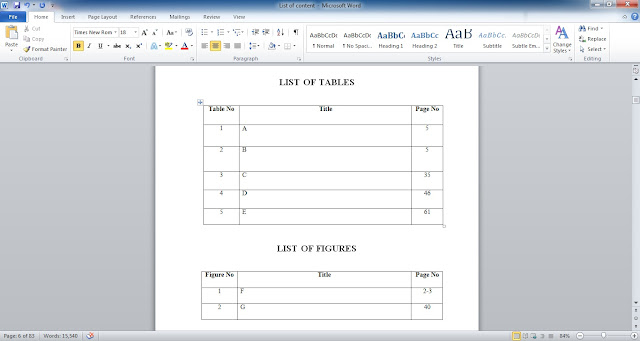Steps to make Introductory Academic Project's Pages
Hello All,
We heartily welcome you to
blog. It seems you want help in making introductory pages of your academic
project. Well, then you have come to a right place. We will provide you - how
to make cover pages for your project.
We will go step-by-step in this.
1) Title Page:-
The first page on the academic project of any
university, whether it is GGSIPU, Delhi University, Sikkim Manipal University
(SMU), AIMA (All India Management Association) etc, is Title Page.
A sample of how to make a title page for a project is shown below:
A Report on
(Project's Full Title here)
Submitted in partial fulfillment of the
requirements
for the award of the degree of
Post Graduate Diploma in Management
(PDGM)
To
All India Management Association (AIMA),
Delhi
Project
Faculty:
Submitted by:
Faculty's name Candidate's name
Registration No:
Batch Year: 2010-2012
Program:
Year 2012 January - June B1
#24-25, 4th Floor, Andhra Association Building, Lodhi Road,
Institutional Area, New Delhi, Delhi 110003
 |
| Example of How to make a first page for a project |
2) Table Of Content:-
The "Table Of
Content" contains all the information of your academic project work - page
by page. This is mainly the second page in the project work, after Title Page.
The Table of Content is
consist of 3 components: Serial Number, Topic, Page Number.
Table Of Content
S
No
|
Topic
|
Page
No
|
1
|
Acknowledgment
|
iii
|
2
|
Executive
Summary
|
iv
|
3
|
List of
Tables
|
vii
|
4
|
List of
figures
|
vii
|
5
|
Chapter-1:
Introduction
|
1
|
6
|
Chapter-2: Literature Review
|
18
|
7
|
Chapter-3: Data Presentation and Analysis
|
61
|
8
|
Chapter-4: Limitations and Conclusion
|
77
|
9
|
Bibliography
|
79
|
3) Acknowledgement:-
In a project work, the acknowledgement plays
a vital role. It states that - who has helped you during your project work, who
was your project mentor, who will check your project, who was your project
faculty. Like this, you have to sum up your acknowledgement in your academic
project work.
A sample of how to make an acknowledgement page for a project is shared below:
ACKNOWLEDGEMENT
At the completion of my
project, I would like to take this opportunity to thank all those who have
extended their support in the smooth completion of this project.
I express a deep sense of
gratitude to Project Faculty’s Name for entrusting me with the
responsibility of this project. I am extremely grateful for her constant
support and valuable advices that helped to complete this project successfully.
Finally, I thank all those who helped me directly or indirectly
during the course of my project.
Candidate’s Name
Registration
No: ________
In the above picture, you can see that,
we have red-colored a page number, which is in Roman. This is because many
universities, like AIMA (All India Management Association), goes for this
format in their project work. So, it is up to you to go like this, or consider
your project details with the university first.
4) List Of Tables & Figures:-
The “list of table” clearly shows that how
many tables are there in your project work. Refrain from using this, if there are
no tables in your project.
A sample of how to make list of figures for an
academic project has been shared below with you:
LIST OF TABLES
Table
No
|
Title
|
Page
No
|
1
|
A
|
5
|
2
|
B
|
5
|
3
|
C
|
35
|
4
|
D
|
46
|
5
|
E
|
61
|
The “list of figures” clearly shows that how
many figures and diagrams are there in your project work. Refrain from using
this, if there are no figures in your project.
A sample of how to make list of figures for an academic project has been shared below with you:
LIST OF FIGURES
Figure
No
|
Title
|
Page
No
|
1
|
F
|
2-3
|
2
|
G
|
40
|
In the above picture, you can see that, we have red-colored a page number, which is in Roman. This is because many universities, like AIMA (All India Management Association), goes for this format in their project work. So, it is up to you to go like this, or consider your project details with the university first.
We have shared relevant pages for a academic project work with you. We can even send it to you in MS-Word format, if you want it for your academic project work, AND IT WILL BE FREE!! Kindly drop us your e-mails in the comment section, on which you require these files.
Best Of Luck..!!





